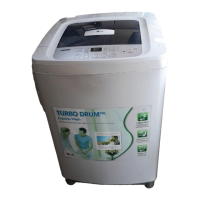
Do you have a question about the LG WFT8500 and is the answer not in the manual?
Precautions regarding hydrogen gas production in water heaters and potential risks.
Guidance on correct installation to prevent electrical shock, fire, or product damage.
Keeping the area around the appliance clear of combustible materials for fire prevention.
Guidelines for safe operation, including child supervision and handling electrical components.
Important warnings and precautions during the machine's washing and spinning cycles.
Guidelines for safely storing the appliance and handling its components when not in use.
Details of the main parts of the washing machine, including dispensers, tub, and control panel.
Lists and illustrations of included accessories such as water supply hoses, drain hose, and anti-rat cover.
Key steps for successful stain removal: promptness, stain identification, pre-treatment, and colorfastness checks.
Detailed treatments for various common stains like blood, grass, ink, and rust on fabrics.
Function of the button to select water temperature settings: Cold, Warm, and Hot.
How to adjust the water level and its relation to detergent amount indicated on the panel.
Causes and solutions for ineffective soil and stain removal, including detergent and temperature.
Addresses issues like blue stains, gray marks, and rust stains, with causes and remedies.
Troubleshooting lint buildup, detergent residue, and scrud formation in the washer.
Identifies causes of fabric damage like holes and tears, and how to prevent them.
Troubleshooting steps for 'IE' error indicating issues with water supply or inlet valve.
Solutions for 'OE' error related to drain hose positioning, blockage, or pump issues.
Checks for 'UE' error, typically caused by unbalanced laundry or an unlevel machine.
Troubleshooting the 'DE' error, ensuring the lid is properly closed for operation.
Guidance for internal sensing, power, and overflow errors (PE, AE, FE) requiring service.